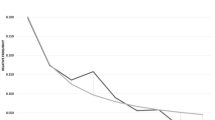Abstract
A notion called “excess wealth” was introduced by Shaked and Shanthikumar around 1998 (Probab. Eng. Inf. Sci. 12:1–23, 1998). Subsequent to this, much has been written on it, mostly by Shaked and his colleagues; see Sordo (Insur. Math. Econ. 45(3):466–469, 2009) for a recent review. These works have appeared in the literatures of reliability theory and stochastic orderings. Since the term excess wealth connotes a measure of income inequality—much like its dual, poverty—it should have had an impact in economics and the econometric literature. This, it appears is not the case, at least to the extent that it should be. The purpose of this paper is to investigate the above disconnect by looking at the notion of excess wealth more carefully, but keeping in mind the angle of economics and income. Our conclusion is that an alternative definition of excess wealth better encapsulates what one means by a colloquial use of the term.
Our motivation for being attracted to this topic arises from two angles. The first is that the stochastics of diagnostic and threat detection tests, in which we have an interest, has a strong bearing on indices of concentration like the Lorenz Curve, the Gini index, and the entropy. Thus the notion of excess wealth, which conveys a sense of income concentration should also be relevant to diagnostics. The second motivation is to honor Moshe Shaked, a prolific researcher and a friend of the first author, by developing a paper based on an idea that is co-attributed to him.















Similar content being viewed by others
References
Basu, A., Shioya, H., & Park, C. (2011). Monographs on statistics and applied probability: Vol. 120. Statistical inference: the minimum distance approach. Boca Raton: Chapman & Hall/CRC Press, Taylor & Francis.
Chandra, M., & Singpurwalla, N. D. (1981). Relationships between some notions which are common to reliability theory and economics. Mathematics of Operations Research, 6(1), 113–121.
Fagiuoli, E., Pellerey, F., & Shaked, M. (1999). A characterization of the dilation order and its application. Statistical Papers, 40(4), 393–406.
Hu, T., Wang, Y., & Zhuang, W. (2012). New properties of the total time on test transform order. Probability in the Engineering and Informational Sciences, 26, 43–60.
Humphreys, P. (1985). Why propensities cannot be probabilities. The Philosophical Review, 94, 557–570.
Kochar, S., Li, X., & Shaked, M. (2002). The total time on test transform and the excess wealth stochastic orders of distributions. Advances in Applied Probability, 34(4), 826–846.
Lindley, D. V., & Phillips, L. D. (1976). Inference for a Bernoulli process (a Bayesian view). American Statistician, 30, 112–119.
Popper, K. R. (1959). The propensity interpretation of probability. British Journal for the Philosophy of Science, 10(37), 25–42.
Sarabia, J. M. (2008). A general definition of the Leimkuhler curve. Journal of Infometrics, 2, 156–163.
Shaked, M., & Shanthikumar, J. G. (1998). Two variability orders. Probability in the Engineering and Informational Sciences, 12, 1–23.
Singpurwalla, N. D. (2006). Reliability and risk: a Bayesian perspective. West Sussex: Wiley.
Sordo, M. A. (2009). Comparing tail variabilities of risks by means of the excess wealth order. Insurance. Mathematics & Economics, 45(3), 466–469.
Acknowledgements
The authors acknowledge the several helpful comments by Professor Shaked which have resulted in the current version of this paper. Professor Nikolai Kolev drew attention to the Leimkuhler Curve. Research supported by the Army Research Office grant W911NF-09-1-0039, and by the National Science Foundation grant DMS-09-15156, with The George Washington University.
Author information
Authors and Affiliations
Corresponding author
Appendix: Exploring the normalized excess wealth function
Appendix: Exploring the normalized excess wealth function
Recall that the normalized excess wealth function is given by the equation
where F is the distribution function of income in a population.
Given below are plots of the normalized excess wealth function for several distributions. For some distributions these are calculated analytically, but for others these were obtained by simulation.
1.1 A.1 A uniform distribution
Suppose that F is a uniform distribution on the interval [0,1]. Then the excess wealth function is
Multiplying by 2 to normalize the excess wealth function, we get
which is a strictly convex function of p—see Fig. 16.
1.2 A.2 An exponential distribution
Suppose that F is an exponential distribution with mean 1. Then the excess wealth function is
Normalizing the above we get
a straight line with slope =−1. Technically this is both a convex and a concave function.
1.3 A.3 A Weibull distribution with shape <1
Suppose F is a Weibull distribution with a scale parameter =1 and a shape parameter =.5, denoted Weibull(1,.5). Then

The excess wealth function is

Normalizing this function we get
which is a strictly concave function of p—see Fig. 17.
1.4 A.4 A Pareto distribution
Suppose that F is a Pareto type II distribution with location parameter =1, and shape parameter =2. For this distribution, \(EW_{F}^{*}\) was obtained by simulation. It is illustrated in Fig. 18 as a strictly concave function of p.
1.5 A.5 A Weibull distribution with shape >1
Suppose that F is a Weibull distribution with scale parameter =1, and shape parameter =2. Then \(EW_{F}^{*}\), obtained by simulation, is illustrated in Fig. 19. Here the normalized excess wealth function is convex in p.
Rights and permissions
About this article
Cite this article
Singpurwalla, N.D., Gordon, A.S. Auditing Shaked and Shanthikumar’s ‘excess wealth’. Ann Oper Res 212, 3–19 (2014). https://doi.org/10.1007/s10479-012-1202-6
Published:
Issue Date:
DOI: https://doi.org/10.1007/s10479-012-1202-6








